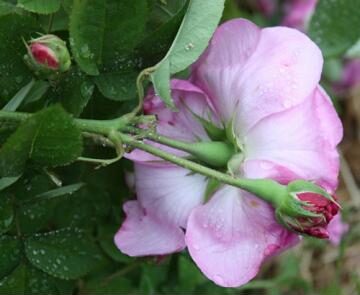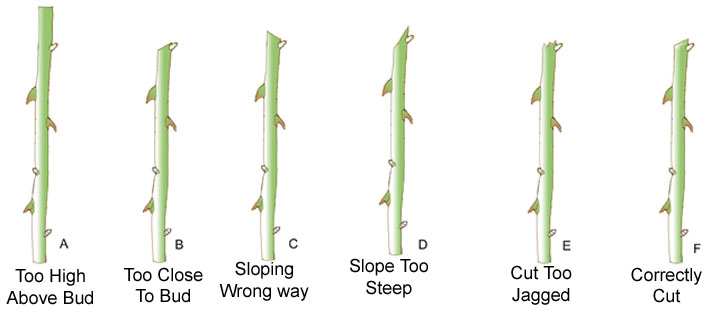Pruning is a great job to undertake but early winter (June), with temperatures still reaching 17 degrees is still too soon. At that time of year many roses enthusiasts are turning their minds to this task. There are principles to be followed if you want to do the right thing, but there is really no need to find it daunting.
Just a few major steps first for beginners.
The more you know about your rose the easier the task will be.
For example:
- Is your rose once-flowering or remontant (repeat flowering)?
- What is its normal growth habit - climber, tall, medium or short bush?
- Do you get frosts in your area? This is very important for the timing of pruning.

When to prune
The time varies according to rose type and location.
If your rose is just once-flowering, it should be pruned as soon as possible after the flowering is finished and this usually means late spring or early summer. Most old and species roses require little or no pruning, other than to keep the plant from growing far too big (so you cut to the size you want – allowing for growth in the following season). The oldest less productive, dry- greyish looking stems can also be removed to encourage the growth of more productive (young , green, sappy-looking) stems from the base or from near the base. I cut out old wood (to the base of the plant) and prune back any branches which are clearly too big (or going to be too big), knowing that although I may lose some flowers by doing this, there will still be a wonderful show in the following season from the many canes I have left. Be aware that any pruning at this time will remove the hips which can otherwise make a wonderful show and be enjoyed throughout the summer and well into autumn.
That is what I usually prefer to do. In autumn, when the hips are past their best, I cut out old wood (to the base of the plant) and prune back any branches which are clearly too big (or going to be too big), knowing that although I may lose some flowers by doing this, there will still be a wonderful show in the following season from the many canes I have left.

Repeat-flowering roses also benefit from being pruned after flowering, so I prune them three or four times each season. It is the severity of the pruning that varies. In summer, most gardeners are happy to just dead- head their roses, and certainly this is usually adequate after the first flowering in the spring. Even at this time, however, I take each stem of a spent flower well back if the rose is a very vigorous variety, so that it does not become too tall or 'leggy' in the summer. Other stems may just be tipped. This procedure is repeated in the summer and perhaps in early autumn (depending on the season and the variety). I have had good flowering well into May, in a season with prolonged warm weather and little rain.
By late autumn or early winter, the rose garden is generally in need of attention, but my advice is to let it rest if possible and not rush into the winter prune (the most severe prune), too early. In so doing, you may be able to enjoy the last few odd roses with their unique touches of autumnal colourings, and you do allow the new young stems to grow and harden off, before you have to consider what should be pruned away. In frost-prone or very cold areas, leave the pruning until all chances of frost or extreme cold are over. If you prune early and warm weather follows, new growth will appear on the plant and this will be damaged when the cold comes. The plant is unnecessarily 'knocked back'. Wait for all leaf fall, to show the plant is dormant.
How to winter prune
After many years of pruning thousands of roses I still most frequently stand in front of each rose and think 'What on earth am I going to do with this?' Over the years, the answers just come a little more quickly.
If the top is very tall, spindly and in my way, I may initially just clip it all off roughly, at one level, with hedge clippers, to allow me to work more easily.
Then I go to the base of the plant and I like to use two handled secateurs to cut out the old stems (see description line 15, above) and any laterals (small stems coming from main ones)which cross over or which are growing towards the middle of the plant. Using my one handled secateurs, I make my way up from the base in this way, aiming to clear the centre of the plant and to maintain a good structure with strong, upright stems forming the shape.
Clear away all leaves and debris that may have collected at the base.
When I reach what can be considered an appropriate height for that plant - short, medium or tall - I then look to prune each stem to a bud at the desired height ( remember to allow for the spring growth). The later you leave the pruning the easier it will be to find a bud, as they begin to swell. Basically, however, there will be a bud at each leaf join. (pull away a leaf from the stem and you will find a slight swelling or even just a line). Find a bud growing in the direction you want the next stem to grow, (usually outwards, keeping the centre free), cut at an angle about one centimetre from the bud, so that the lowest part of the cut is on the side opposite to the bud. (this is the ideal, but if it sounds too complex do not be overly concerned; just cut at this level and with time as you become used to pruning, you will find appropriate buds easily). Shape the top of the plant as you desire – stems should usually be of similar height or perhaps reach a dome shape if there are many.
Carry away and dispose of all prunings and leaf litter as they harbour diseases.
Spray plant and surrounding area with lime sulphur to keep diseases such as blackspot at bay.
Pruning climbers
This is a task that is even more clearly demonstrated in the garden, but basically the same principles apply as those given for bushes. Each year one or more of the oldest canes may be selected to be pruned out to encourage new basal growth. The remaining long canes are best bent and fixed in fan shape or horizontally, as flowering will then occur at frequent intervals. If this is not possible and all the growth is to be vertical, with flowering just at the top of each stem, cut these at different levels. For example, if stems are upright against a wall, pole or fence, leave the back two or three as tall as possible (or desired), select the next two or three and prune them somewhat shorter, and so on down the plant in a graded effect, with the shortest at the front. Flowers will then develop at all levels instead of the unappealing 'bare-legged look' with all the flowering at the top and just stems at eye-level and below.
There is no need to feed at this time. Wait until the warmer weather comes and the first signs of growth (buds swelling) can be seen. You will be well rewarded within a few short weeks!
by Sophie Adamson
Additional comments:
- Roses are considered as pest plants in terms of rubbish removal, and may not be included in "green waste" or plant trimmings intended for compost for general sale.
- Tea and China roses are best deadheaded through the season, with a light trim in autumn to encourage winter flowers, followed by a "Hygiene Prune" in winter (removing dead wood and crossing-over branches).. A more substantial pruning can be done every 3-4 years, but never more than 1/3 of the plant.
- Polyanthas are best given a "haircut" of about 1/3 of the bush in winter.
Margaret Furness
